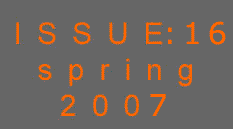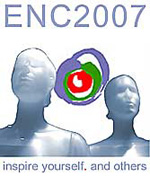

YGN BNES activities
Rough Guide to the Nuclear Industry 2006: Sellafield,
UK,
11 -13 October.
The 2006 BNES YGN Rough Guide to the Nuclear
Industry was an event which brought together more than 30 young
professional BNES members from a varied cross-section of the nuclear
industry. The organisations represented by the delegates included
those involved in nuclear power generation, submarine development
and decommissioning, waste retrieval and disposal, general nuclear
legacy decommissioning and industry regulation.
The Event took place at the Sellafield Visitors
Centre in West Cumbria. It provided attendees with an excellent
chance to broaden their knowledge of the nuclear industry as a
whole, both through interaction and discussions with other delegates
of varying backgrounds attending the event, as well as through
the wide range of topics discussed in the various presentations.
The visits to the Sellafield site which were undertaken also provided
an invaluable opportunity to see some of the operations and theory
that had been outlined in the preceding presentations, put into
practice.
The event was opened with a ‘Welcome to
Sellafield’ presentation by Peter Lutwyche which provided
a brief history of Sellafield as well as outlining some interesting
facts and figures on the current operations and future plans for
the site. This was followed by an Introduction to the Nuclear
Fuel Cycle given by Neil Blundell from the Nuclear Installations
Inspectorate (NII). Together, these opening presentations provided
a strong foundation for what was to follow and were well received,
especially by those delegates with less experience in these particular
areas.
Following these introductory sessions, Neil Blundell
continued by providing an insight into the work and workings of
the NII. This included a brief history of the regulatory body
as well as an overview of the areas impacted by the NII and the
kind of day to day tasks which are carried out by inspectors working
for the organisation.
The afternoon of Day 1 began with a presentation
on how the formation of the Nuclear Decommissioning Authority
(NDA) has affected the decommissioning and clean-up sectors of
the industry, in particular with respect to short and long term
strategy planning. This was closely followed by a brief synopsis
of the work of the British Nuclear Energy Society's Young Generation
Network (YGN), the organisation responsible for putting on the
conference, given by YGN Vice-Chair, Neil Crewdson.
The first day closed with two presentations on
widely varying subjects, showcasing the diversity of topics this
event was designed to cover. The first of these was a fascinating
and frank discussion on the problem of the long-term management
of radioactive waste given by Nirex, advisors to the UK government
on this subject. The second was a talk on the manufacture and
use of industrial sources of radiation, provided by Duncan Aston
of High Technology Sources Ltd.
Day 1 ended with a meal attended by all the delegates,
as well as other members of the YGN, which afforded a valuable
chance for conversation and networking between delegates from
different companies and areas of the industry.
The first two lectures on Day 2 were largely
based around the theme of decommissioning. The first of these
was given by Andy Scargill, Sellafield Superintendent for Decommissioning,
and presented an overview of the challenges faced at Sellafield
and some of the solutions which have been utilised to overcome
them. Emphasis was then placed on the afternoons visit to the
Calder Hall site with a presentation from site manager Paul Brennan
on its past, present and future.
The morning was rounded off by a talk from the
present CEO of British Nuclear Group, Lawrie Haynes, which was
a very positive look at how innovation will be key to the future
of the nuclear industry and, hence, how young people coming into
the sector are of paramount importance in shaping its future.
The afternoon then consisted of two site visits.
The first of these, a visit to the Calder Works including the
Calder Reactor and Turbine Hall, tied in with the mornings corresponding
presentation and gave a unique insight into the life cycle of
a nuclear plant through construction to commissioning, decommissioning
and finally demolition. The second visit of the afternoon was
a very informative overview of the Thermal Oxide Reprocessing
Plant (Thorp). This gave a detailed summary of all Thorp reprocessing
operations, taking in everything from receipt and storage through
to the chemical separation part of the process.
The final day began with Steve Bostock, Head
of Magnox Reprocessing Operations, explaining the process and
plant interdependencies of the Sellafield Magnesium Oxide reprocessing
cycle. This edifying lecture served as an excellent preface to
the site visits which followed. These incorporated tours of the
Fuel Handling Plant, where spent fuel from nuclear reactors across
the country is received and prepared for reprocessing; the Separation
Area, where the re-usable Uranium and Plutonium from spent fuel
are separated from other fission products; and the Magnox Encapsulation
Plant (MEP), where fuel cladding materials are encapsulated in
grout and safely stored. Overall the days visits demonstrated
how several different plants can link together to form one process
as well as the reliance of each individual plant on the performance
of others within that process chain.
The whole event was brought to a close on the
final afternoon by two further presentations. The first came from
the Nuclear Industry Association, the trade association and information
body for the UK civil nuclear industry. This was followed by a
fitting closing discussion and Q&A session on corporate social
responsibility in the nuclear industry, led by David Bonser, BNFL
Director.
The event more than achieved its initial aims
of providing a broad impression of the industry as a whole, whilst
also giving a more in-depth analysis of certain aspects of the
exciting challenges and opportunities which exist within the industry
both presently and looking to the future.
There was a diverse mix of backgrounds and experience
in the group of attendees present and it was testament to the
thought and organisation which had obviously gone into the planning
of the event that each one of these attendees went away having
not only thoroughly enjoyed it, but also having taken in plenty
of useful information about, and with an improved understanding
of, their industry.
The event highlighted the positive aspects of
the nuclear sector and showed that there is plenty of outstanding
work going on across many disciplines and fields of expertise
within the industry. It left the delegates with the knowledge
that better communication, both internally and externally, can
only lead to an improved perception of, and confidence in, the
nuclear industry, thus ensuring a bright outlook for their respective
futures in nuclear.
Chris Farrell, British Nuclear Group.
PM Visit to Sellafield
Tony Blair’s visit to Sellafield –
The YGN perspective by Matthew Aukett
The Prime Minister made a suprise visit to the
Sellafield Nuclear Complex on the 16th November and requested
to meet with younger members of the industry, including apprentices,
graduates and members of the BNES Young Generation Network. Following
Mr. Blair’s guided tour of the site, Linda McLean and Matthew
Autket had the opportunity to welcome Mr. Blair off the tour bus
and took him meet 8 fellow young members of the nulcear industry,
including two YGN core committee members. Mr. Blair enquired about
what work people were undertaking and their career history. He
then proceeded to the British Technology Centre, where he gave
a speech to a selection of the workforce. During his speech he
commended the work being undertaken at Sellafield as a part of
the clean-up mission and gave an extremely uplifting and positive
speech about the future of the industry and the Sellafield site.
In summing up the importance of the Prime Minister’s
desire to meet the next generation of the nuclear industry, Linda
McLean said: "The fact that the Prime Minister took time
out from a very busy schedule specifically to meet some of the
graduates, apprentices and young generation shows he understands
nuclear is not an industry that is in decline, but is rather an
industry that is providing lots of interesting and challenging
opportunities, noting today's 'Younger Generation' is key to the
success of the industry."
Christian Guiotto
YGN Comms Officer
www.ygn.bnes.com

Hello, and welcome to the YGN Education &
Training e-Bulletin. This month we take a look at Sheffield
University and its internationally renowned Immobilisation
Science Laboratory (ISL). Plus, in this bulletin,
we also provide a 2007 events update.
The ISL is based at the Department of Engineering
Materials at the University of Sheffield. It offers educational
and training opportunities at undergraduate, masters and postgraduate
level. Students studying for either a Batchelor or Master of Engineering
Degree have radioactive waste immobilisation techniques taught
them as part of their course. Students on the M.Eng, can supplement
this with a long term project in their final year on a specific
radwaste topic.
|
The Nuclear Environmental Science and Technology
M.Sc. course is specifically designed to teach the fundamental
underpinning science of waste immobilisation. Advanced courses
on cements, glasses and ceramics are supported by lecturers
from industry giving the students their experience of site
specific problems.
PhD projects within the ISL are available
in five specific areas of immobilisation, cements, glasses,
|
 |

|
ceramics, materials modelling or deep
borehole disposal. Most students at the ISL have an academic
and industrial supervisor and benefit greatly from this
close association with industry. If you are interested in
studying for a Ph.D. on any of these topics please contact
the ISL Manager Dr John Roberts via the details below. |
The Radioactive Waste Immobilisation Network
(RWIN) is co-ordinated by the ISL and holds regular meetings on
radwaste at various locations throughout the UK. The meetings
showcase current technologies and are an excellent way for the
radwaste community to stay up to date as well as providing education
and training to people new to the field. Further details are available
from the RWIN website at:
www.rwin.org.uk
MRS 2007 Symposium on the Scientific Basis for
Radioactive Waste Management
The ISL is hosting the 31st Annual Meeting of
the most important technical event on the international radwaste
calendar. The meeting will be held in Sheffield from September
16 - 21 2007 bringing together scientists from all over the world
to present their work. More information including the call for
abstracts, which is now open, is available from the website mrs2007.sheffield.ac.uk
To find out more about Education and Training
opportunities at the ISL please contact the ISL Manager at j.w.roberts@sheffield.ac.uk
or visit the ISL website at www.immobilisation.net
The cutting edge academic work that the ISL and
Sheffield University carry out may seem a bit academic to some
people but it provides an alternative and benchmarking way of
working for the industry. The eagerness to engage with industry
and maintain links with the R&D sector should see its work
grow in influence, especially in cementitious immobilisation.
YGN 2007 Event Update:
26
– 28 March
|
YGN
Reactor Seminar
|
FULLY
BOOKED (Reserve places only) |
| May
2007 |
YGN
Defence Seminar |
NEW
THIS YEAR! BOOKING SOON |
| September
2007 |
ICEM
’07 |
YGN
SESSION AT INTERNATIONAL CONF |
| September
2007 |
France,
Technical Tour |
BOOKING
SOON |
| 10–
12 October |
YGN
Rough Guide to Sellafield |
FULLY
BOOKED (Reserve places only) |
| 26
October (tbc) |
YGN
Annual Dinner |
BOOKING
SOON |
|







